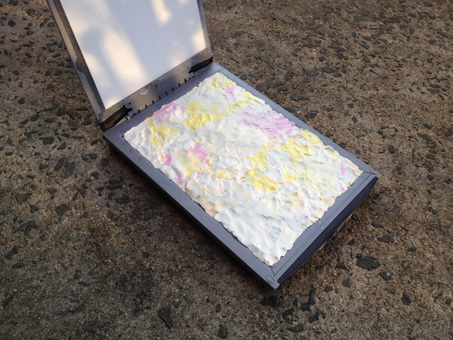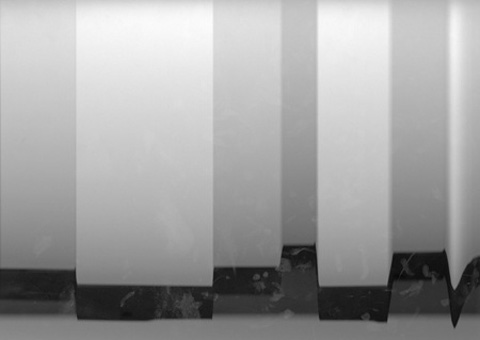
Prepared Scanner, a composition in clay (Travess Smalley, 2011)

Untitled (Jo-ey Tang, 2011-2012)
Rhizome asked Travess Smalley and Jo-ey Tang, two artists with digitally-based work in the upcoming group exhibition "The Untouchables" at Saamlung in Hong Kong, to answer the same question(s) via email.
Surface is a theme of this show: is there a particular way you connect the visual elements of your pieces to something non-visual? Considering each piece has a digital and physical aspect, would you expand on the relationship between the two forms? What do you consider your pieces to be made of (e.g., substance, bit, concept, etc.)?
Travess Smalley: I have always looked for ways to bring the home office into my studio practice. I mean, for most artists the home office holds many of the tools we use on a day-to-day basis -- inkjet printer, scanner, personal computer, even scotch tape and staples. I've always felt that my role as an artist and creator would be somewhat dependent on these tools. I mean, it's always been easier for me to find a mouse than a paintbrush.
Of all the home office devices, the printer/scanner is the most interesting to me. These are the two devices that convert the digital to the physical and back again. They are one of the few ports where the visual can get in and out of the separated digital and physical worlds. The printer and scanner have been my most important tools for the past few years. From my experiences and processes using them for artistic ends, I have come to think of my relationship to them akin to a contemporary printmaker. A home office printmaker perhaps. I've developed an understanding and elaborate choreography of process that attempts to blur the line of these convertors. It rarely actually blurs the distinction of the physical and digital for me, but I'm thrilled when it appears indistinguishable to others.

Prepared Scanner, a composition in clay (Travess Smalley, 2011)
Last year, I made a book of collages called Capture Physical Presence. The collages themselves are hybrid objects: compositions that are as much digital as they are physical. Through being digitized on the scanner and physically printed repeatedly, they are images that no longer have a set medium or even a "proper" or "finalized" way to be presented. To see the physical collages is nothing like what you'd find on the digital altered image on the screen, which once again is not really the same as the image that was flattened and printed in the book. For Capture Physical Presence, I started by constructing digital images and gradients in Photoshop and then printed them out. Once printed, I cut them up and physically collaged them with other print-outs from digital files, as well as from other papers and photos. From these physical collages, I scanned the physical compositions back into my computer. This digital/physical process continued, creating a sort of dissonant medium that was not quite digital nor physical. No longer is a pixel distinguishable. Neither is print toner. What is left is some hybrid other. I love when the medium starts to corrode this way. My generation is good at discerning the credibility of an image (understanding if an image has been digitally altered). It's satisfying when a viewer looks at these works and cannot easily recognize the medium, let alone if it's been altered, or even how it is made.

Prepared Scanner, a composition in clay (Travess Smalley, 2011)
I digress into my history with the scanner only to explain and help inform how I am using it in this current series of sculpture objects. For "The Untouchables" at Saamlung Gallery, I will be showing a series of prepared scanners. Each scanner lays open, displaying paintings made with clay. The paintings are tightly composed on top of the scanning glass. I used a type of clay called plastalina, a very vibrant, yet highly malleable and expressive material that shows all of my fingerprints and gestures. While the viewers of the exhibition will see these expressive compositions and textures framed by the "home office"greys and fading plastics of the various scanner beds, a whole other image can be viewed digitally from the scanner as a functional object. The scanner then becomes not only the artwork, but the means for producing the digital work. Specifically, the user of the sculpture can create a digital image that can be blown up quite large.

Prepared Scanner, a composition in clay (Travess Smalley, 2011)
In most of my practice I try to find modes for coming to terms with the dual physical/digital studio practice that almost all artists currently find themselves in. I am involved in ways of bringing my painterly and formal practice into conceptual unison with the practicalities of a digital life. With the prepared scanners, I am able to explore elements of composition, form, and texture and involve those directly in the discussion of art making after the physical. Specifically, I have been really drawn to clay and plaster because as a medium it possesses so many of the characteristics I was using and imitating with Photoshop. The liquify tool swirls around a digital image in much the same way that I gradually work colors into wet plaster.

Untitled (Jo-ey Tang, 2011-2012)
Jo-ey Tang: Surface is where the work’s limit resides. The subject/object of vision is always that surface that comes between you (the viewer) and I; it is that mental and physical thing that allows the constant movements and obstructions of subjectivity and objectivity.
It’s contemporary consciousness that I engage in, not digital per se. Think of digits (fingers) in the digital, as both embedded and disembodied. Proof (the scanner plane), and its distance, enabled by the physical acts of moving the scanner lid towards and away from the machine.
The images are willing the impossibility of an empty image into existence. The trio of images (only two will be shown at the exhibition) are my only and last images with a flatbed scanner.

